Colin Mustful's Blog, page 12
February 16, 2020
Lessons from the novel Resisting Removal: Julius Austrian
February 9, 2020
Lessons from the novel Resisting Removal: 1854 Treaty of La Pointe
February 2, 2020
Book Review: “Massacre in Minnesota” by Gary Clayton Anderson
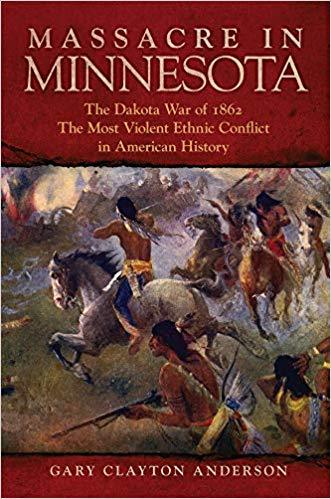
Title: Massacre in Minnesota: The Dakota War of 1862, the Most Violent Ethnic Conflict in American History
Author: Gary Clayton Anderson
Publisher: University of Oklahoma Press, 2019
One hundred and fifty eight years ago, war tore through the Minnesota River valley forever altering the social, cultural, and historical landscape of a once quaint frontier community. The U.S. – Dakota War of 1862 was a tragic, watershed event that has left behind a changing narrative that historians still grapple with today.
In the 1980s, historian Gary Clayton Anderson confronted the enigmatic historical event with a series of books. The first was Kinsmen of Another Kind (1984), a finalist for the Pulitzer Prize, followed by Little Crow: Spokesman for the Sioux (1986), and finally, Through Dakota Eyes: Narrative Accounts of the Minnesota Indian War of 1862 (1988). Now, more than thirty years later, the accomplished historian has returned to the 1862 war with his new book, Massacre in Minnesota: The Dakota War of 1862, the Most Violent Ethnic Conflict in American History.
One of the most intriguing elements of the U.S. – Dakota War is its ever-changing name. Throughout much of the 20th century it was known as the Sioux Uprising, a now clear but still debated misnomer because of both the words “Sioux” and “Uprising.” Anderson shows that he is not immune to changing perspectives while also wading into the controversial waters by calling the 1862 event a “massacre” a “war” and an “ethnic conflict” all in the same title. Also, the cover image he chose is titled, The Siege of New Ulm, a 1902 painting by August Schwabe that could easily provoke the ire of some readers in his audience for its single-minded portrayal of Dakota soldiers on the attack.
“Never had an American frontier community been more closely aligned in supporting a policy approaching genocide than in Minnesota in the late fall of 1862.”
Despite the apprehension the title and cover image may evoke, after reading Anderson’s exhaustive historical account, I believe it rises above any form of subjective, limited account that marks much of the historical record on the U.S. – Dakota War. Like any good historian, Anderson combs through multitudes of accounts and records while laboring over every detail of the war and its aftermath. Also, Anderson appropriately provides much needed context of the events before and during the war in order to understand exactly why tragedy struck.
One of the most impressive elements of Anderson’s new book, is his boldness to take on every aspect of the U.S. – Dakota War no matter how or if those elements have been considered by previous historians. This comes across most clearly in the chapter titled “Captives and the “Fate Worse Than Death.”” In it, the historian examines the role of sexual abuse during the war. Anderson readily admits that most historians have ignored the subject, rather than get mired in something that is so difficult to sort out fact from fiction. Women at the time, for various reasons, were unwilling to talk openly about their treatment as captives which makes it challenging to draw any conclusions about the true nature of captivity. But Anderson proceeds anyway, examining the records, considering social context, and drawing reasonable conclusions about what was meant by “the fate worse than death.”
In the same way, Anderson delves into other elements of the war by taking apart and reconstructing the sources in a way that thoroughly and objectivity provides realistic conclusions. Take, for instance, the Treaties of Traverse des Sioux and Mendota in which the Dakota sold their lands west of the Mississippi River in exchange for a reservation along the Minnesota River. Although it would be easy to say that the Dakota were cheated out of hundreds of thousands of dollars and forced to give up their traditions and homeland, Anderson carefully examines the payment and its aftermath to show readers exactly what happened. Citing numerous sources, the author provides real data—to the penny—about what money was exchanged, when, and to whom. He also revisits the roles of men like Henry Sibley, Alexander Ramsey, and Joseph R. Brown. Finally, he does not spare the settlers who took advantage of the situation by burning Dakota villages prior to ratification of the treaty and who also called upon “settler sovereignty” to take land as they pleased as if they were entitled.
“The entire debt scenario was a massive fabrication.”
The Dakota were not blameless in the events of 1862. By scouring the records, Anderson takes on the role of the Dakota while also providing accurate details about the deaths and captivity of settlers. While many accounts of the attacks have been aggregated over time, Anderson puts forth the effort to analyze those accounts and determine the number of innocent civilians killed and through what means. He provides numbers and details that allow readers to know and understand the exact sequence of the battles and who was involved. He also looks at the nature of warfare among the Dakota, the factionalism between the akacita (soldier’s lodge) and chiefs, the factionalism between the Mdewakanton and other bands, and the portrayal and legacy of Little Crow.
“The flight from twenty-six Minnesota counties constituted the largest forced exodus in American history.”
Many Minnesotans have learned that thirty-eight Dakota men were hanged in Mankato on December 26, 1862, in what is the largest mass execution in United States history. But for those who still want to know why, or for those who still question the truth behind the history they already learned, I cannot more highly recommend Gary Clayton Anderson’s Massacre in Minnesota: The Dakota War of 1862, the Most Violent Ethnic Conflict in American History. The book, I believe, represents the pinnacle of historical responsibility. Anderson does not rely on previous accounts to regurgitate a biased narrative. Nor does he shy away from controversial topics that could expose his work to criticism. Anderson, through exhaustive research, uses the tools available to him to completely deconstruct the U.S. – Dakota War of 1862 and then puts it back together again in an objective manner cultivating truth over exaggeration. The result can be painful for readers to see—genocide, corruption, rape—but it was all a part of Minnesota history. As Anderson points out, “accounts that are designed to vilify or honor the actions of men and women who are undeserving of either only compound the problem associated with facing our past.” Instead, we must come to know our history, even if consensus is impossible, otherwise we are indeed doomed to repeat it.
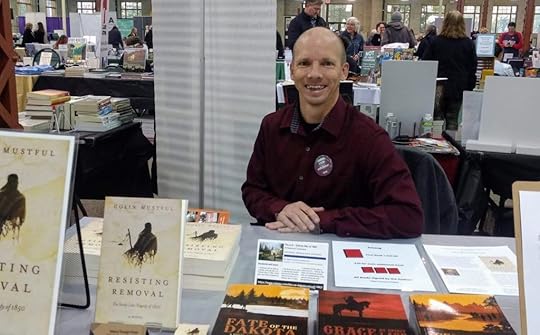
Colin Mustful is a Minnesota author and historian with a unique story-telling style that tells History Through Fiction. His work focuses on Minnesota and surrounding regions during the complex transitional period as land was transferred from Native peoples to American hands. Mustful strives to create compelling stories about the real-life people and events of a tumultuous and forgotten past.
January 27, 2020
Let’s talk about money – my 2019 revenue and expenses.
In 2019, I had many great accomplishments as a writer. Most notably, I earned an MFA in creative writing, I released my fourth historical novel, and I launched my own publishing company. I am tremendously proud of these achievements and I look forward to my continued development and success.
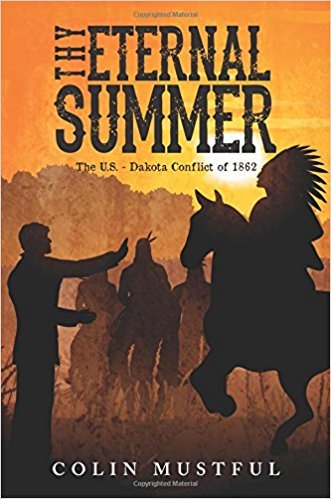 My first novel, Thy Eternal Summer, was published by Tate Publishing in 2013
My first novel, Thy Eternal Summer, was published by Tate Publishing in 2013I began seriously pursuing writing as a career in 2010 when I quit my job as a parking lot attendant and started writing my first novel. Since that time, I have learned a lot about the work that is required to be an author. Not only have I had to develop my craft as a writer, but I’ve had to learn about the important business and marketing elements that come with the publication of a novel. These important business elements include things such as building an online presence, developing a platform, branding, advertising, and public speaking. For instance, in 2019, in addition to completing my Master’s thesis, publishing a novel, and starting a new novel, I published 21 YouTube videos, dozens of blog posts, 9 author interviews, and I had 18 author events in the states of Minnesota, Iowa, and Wisconsin. Also, I managed two websites, numerous social media accounts, and worked as the editor of my publishing company receiving and responding to submissions.
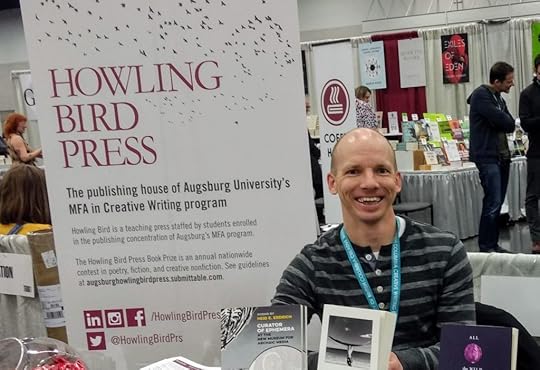 Colin Mustful at the 2019 AWP Conference and Book Fair in Portland, Oregon
Colin Mustful at the 2019 AWP Conference and Book Fair in Portland, OregonThe most important part of my writing, is sharing with readers the complicated, often tragic, history of Minnesota and surrounding regions during a period of settler colonialism and Native displacement on which our country is founded. The pursuit of knowledge, understanding, and healing is and always will remain my central focus, though my writing may or may not change over the years. With that said, I’ve discovered that many readers are interested in more than just the history behind my writing. Often, patrons at my speaking events ask me about the role of being an author. They are curious about the sacrifices and gains and they wish to know if I make my living as an author, or if I rely on outside income. Because of the interest shown by my readers and patrons of my events, I’ve decided to share the (current) financial aspects of my work as a writer/author/historian. I will note here that I do not make my living as an author. Rather, I work as a para educator, a pizza delivery driver, and a soccer coach.
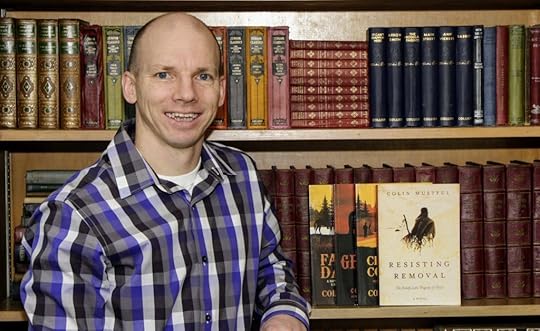 Colin Mustful pictured with his novels.
Colin Mustful pictured with his novels. Before sharing this information, I must preface it by expressing that every author’s experience is different and is dependent on the goals of the writer and the manner in which they publish. Below you will find a record of my costs and revenues as an independent author for the year 2019. It is not meant to encourage or discourage writers or readers in any way. It is meant only in the interest of transparency—to give people an idea of the financial costs and rewards of my own personal experience as an author. I am very proud of the work I have done, no matter the gains or losses, and I will continue to pursue my path wherever it leads.
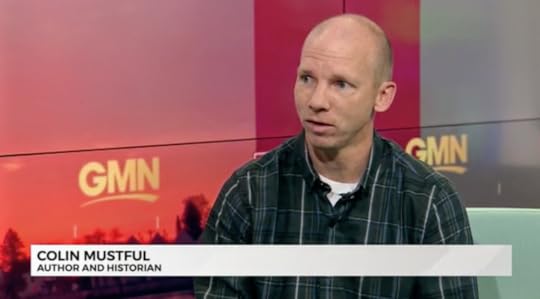 Colin Mustful speaks about his new book Resisting Removal on a Duluth TV news station in September 2019
Colin Mustful speaks about his new book Resisting Removal on a Duluth TV news station in September 2019As I progress in my career as a writer, I will continue to pursue all opportunities to share my work, develop my craft, and seek out new ways to earn a livable wage. Over time I have gained a wealth of experience and knowledge which I am available to share through speaking engagements, freelance editing and writing, contract work, conference panels, and collaboration. I invite you to contact me if you have or recognize any opportunities for me as an author and historian. Lastly, if you value literature and the work of independent authors and bookstores, please support them through word-of-mouth, positive reviews, and purchases of their work.
Thank you! I hope you find this information interesting and I look forward to sharing more with readers in the years to come.
Author Sales and Revenues (Sales through Ingram include only the title, Resisting Removal. Sales through Lulu include all other titles. Revenues for sales in the final three months of 2019 have not yet been received by the author)
Print books sold through online distribution channels (Ingram) – 144
Electronic books sold through online distribution channels (Ingram) – 15
Revenue from online distribution channels (Ingram) – $144.89
Print books sold through online distribution channels (Lulu) – 7
Electronic books sold through online distribution channels (Lulu) – 3
Revenue from online distribution channels (Lulu, books only) – $26.35
Print and electronic essays sold through online distribution channels (Lulu) – 10
Revenue from online distribution channels (Lulu, essays only) – $0
Total books/essays sold through all distribution channels – 179
Total Revenue from all online distribution channels – $171.24
Total books sold through non-events (i.e. in-person, author website, etc.) – 43
Total Revenue from non-event sales – $527.81
Total books sold at author events (18 total events) – 201
Total revenue from author event sales – $2,883.77
Speaking fees collected – $1,548.58
Total books/essays sold from all sources – 423
Total gross author income – $5,131.40
Author Expenses
General expenses (i.e. conference registrations, writing materials, website related fees, State sales tax, etc.) – $2,210.42
Books Giveaways (reviewers, contests, etc.) – 25 total books
Advertising – $1,412.69
Shipping Costs – $212.86
Books ordered through Ingram – 186 for $1,105.70
Books ordered through Lulu – 99 for $746.51
Payments to freelancers (social media manager, cover designer) – $2,370.00
General expenses at events (food, transportation, etc.) – $397.67
Lodging at events – $411.01
Total miles driven for events – 4300
Gasoline costs – $294.91
Total Author Related Expenses – $9,161.77
January 26, 2020
Lessons from the novel Resisting Removal: Willis Gorman and Henry Gilbert
January 19, 2020
Lessons from the novel Resisting Removal: Ma’iingan—the Brother Wolf
January 12, 2020
Featured Author – Manybooks.net
Recently, I was featured on ManyBooks.net. I have posted the interview below. You can find the original interview on Manybooks.net.
Colin Mustful – Bringing History To Life
Colin Mustful is a Minnesota author and historian whose work focusses on the complicated and tumultuous time period when land was exchanged between Native and American hands. Using elements of fiction and nonfiction, Mustful’s work relies on real historical figures and documentation while creating compelling narratives that bring history to life. As our Author of the Day, Mustful tells us all about his book, Resisting Removal.
Please give us a short introduction to what Resisting Removal is about.
In the early winter of 1850, four hundred Ojibwe perished at Sandy Lake, Minnesota, because of the negligence and ill-intents of U.S. government officials. Based on real correspondence from the time period, Resisting Removal tells the story of the Ojibwe people’s perseverance to resist the illegal removal efforts of the U.S. government and earn permanent reservation homes in their homeland.
What inspired you to write about the Sandy Lake Tragedy?
As a Minnesota historian, I am quite interested in the U.S. – Dakota War of 1862, a tragic event that resulted in the hanging of thirty-eight Dakota men in Mankato, Minnesota on December 26, 1862. After many years of study about the U.S. – Dakota War, I was shocked and saddened to learn about the Sandy Lake Tragedy of 1850, an event that left four hundred Ojibwe dead in northern Minnesota. It’s an unfortunate, but important part of our history, and I want to create awareness around the truth of our past. Hopefully, knowledge about the inequities of the past will lead to a more equitable, just, and prosperous future.
Your novel also exposes the corruption and negligence of the Indian System. Why did you find this important to do?
It’s shocking to read the correspondence from the time period. Native peoples were dehumanized and the men who exploited them were never held accountable. I don’t wish to pull them from the context in which they lived, but I do think it is important to acknowledge and understand the viewpoints of the past in order to avoid the same mistakes while constantly reexamining who we are and how we treat each other.
How much research did this book require from you? What was the most interesting aspect of this research?
The novel required a vast amount of research. Luckily, I was able to rely on the work of Bruce White, a historian who wrote a thoroughly cited essay for the Supreme Court in 1999 in a case between the Mille Lacs Band of Ojibwe and the State of Minnesota. The essay is titled, The Regional Context of the Removal Order of 1850, and it adequately summarized the time period on which my book focuses. This essay pointed me to correspondences and reports that were quite revealing written between traders, missionaries, and government officials. I was able to locate the original documents in the Manuscript Collections of the Minnesota Historical Society. I also relied heavily on the memoir of Benjamin Armstrong, a white trader and store clerk from Alabama who moved to La Pointe in the 1840s and married into the Ojibwe community. He acts as the main character of my novel. Finally, for knowledge about Ojibwe history and culture, I relied on the work of Ojibwe historian William Warren, who recorded the oral tradition of the Ojibwe people. His work was published posthumously in a book titled, History of the Ojibway Nation.
Why did you title this book “Resisting Removal”?
First, because the story is about the Ojibwe people’s efforts to consistently resist the removal efforts and policy of the U.S. government. Also, because of the alliteration.
Besides writing, what other secret skills do you have?
I am an amazing soccer player, a marathon runner, and I’ve worked in the pizza industry for almost twenty years.
Please tell us more about the cover and how it came about.
The cover is the work of Ryan Scheife of Mayfly Design in Minneapolis. Working with Ryan was a wonderful experience and I gave him a lot of creative freedom when creating the cover. He came up with the central image and we collaborated on the idea to place a transparent map of the region in the background. As for the colors and font, Ryan deserves all the credit. I highly recommend working with Mayfly Design. You can find him online here: http://mayflydesign.com/.
Why historical fiction? What drew you to the genre?
Interestingly, I’m not much of a fiction reader. However, I understand that fiction appeals to a wider audience of people than nonfiction. The history I write about is very important, but not very well-known. Plenty of nonfiction texts exist regarding this history, but most people simply are not interested in bland, nonfiction text. I wanted to reach readers that otherwise would not be interested in history. In order to do that, I had to write fiction, but I did it in such a way that still maintains integrity for the historical process. I consider myself a historian first and a fiction writer second.
What advice would you give to your younger self?
There is really no advice I could give myself. Writing and the publishing process is a learning experience. It’s long and filled with failures and mistakes, but it’s the only way to learn and grow. If I gave myself any advice I would say, be kind to yourself and patient.
What is the hardest thing about being a writer?
For me, the hardest part of being a writer is understanding the human experience. Fiction is about creating a meaningful, emotional response in your readers. In order to do that, the writer needs to create relatable, realistic, and nuanced characters that experience all the joys and sorrows of real people. I find it extremely challenging to convey the emotional and psychological depth of real people in a way that elicits a meaningful response.
Which famous person, living or dead would you like to meet and why?
Kirby Puckett. He was my childhood hero.
Do you have any interesting writing habits? What is an average writing day like for you?
My writing life is as varied as my professional, family, and personal life. I work several jobs. I play sports. I travel. I write when it suits me knowing that the process is long, but understanding that dedication and persistence are key. As long as I’m spending time each day (or most days) toward accomplishing my writing goals and tasks, then that is enough.
What are you working on right now?
I am challenging myself to write a story that relies more on character development and less on history. It’s an alternative history that reimagines the U.S. – Dakota War of 1862, as if the Dakota joined forces with the Ojibwe and defeated U.S. forces. I hope to show readers, especially Minnesotans, the real impact of history, and how and why it is important to right the wrongs of those who came before us.
I’ve also recently launched my own publishing company called History Through Fiction. I am currently reviewing manuscripts and I have signed my first author to a contract. The author is Nancy Burkhalter and her book, The Education of Delhomme, tells the story of the famed French Pianist Frederic Chopin during the 1848 French worker’s revolution. It is scheduled for release in the fall of 2020.
Where can our readers discover more of your work or interact with you?
Please look through my website at http://www.colinmustful.com. In addition to my novels, I have an active blog, links to my social media accounts including my YouTube channel, resources for teachers, and published essays. If readers subscribe to my website, they’ll receive a free downloadable copy of my first novel, Fate of the Dakota: A Novel and Resource on the U.S. – Dakota War of 1862. Readers can also learn about my publishing company History Through Fiction at http://www.historythroughfiction.com.
January 5, 2020
Lessons from the Novel Resisting Removal: George Manypenny
January 1, 2020
The Truth of my Story
In September 2018, my teaching mentor asked me to write “the truth of my story.” I’m not completely sure what he meant by that and I remain unsure today. Nonetheless, I wrote my story and I would like to share it here today. I invite your thoughts and comments and I encourage you to write the truth of your own story, whatever that may mean.
The Truth of My Story
I
hate running.
Or,
rather, I don’t feel naturally inclined to running. It’s difficult and time
consuming. I don’t like feeling exhausted or intentionally causing myself pain
and discomfort. Also, it tends to be very boring, especially on a treadmill
when there is no change of scenery. Running doesn’t give me much personal satisfaction
or joy. Yet, in my life I have completed nine marathons, one fifty-mile
ultra-marathon, and countless half-marathons, 5ks, 10 milers, and so on. I have
chosen, despite my natural interests, to run and I have chosen it time and
again.
When
I completed my ultra-marathon after ten hours and thirty-one minutes of effort,
I actually cried I was so tired. They were not tears of joy—they were tears of
sheer exhaustion. I had done all I could to complete the race and by the end I
was too tired to think, to move, to exist. I did not compete against anyone. I
ran alone. I had no decipherable purpose but to accomplish a difficult
endeavor.
I
run not because I enjoy it, I run because I believe it has value. Running
provides me with strength and stamina. Running is challenging. It provides at
least as many mental challenges as it does physical. I run to be a better
soccer player, so that I know before every game that I have provided myself
with the best opportunity to be successful. I run because I believe that it is
the right thing to do. I do not like it. I do not enjoy it. I am not fulfilled
by it. Rather, I am enriched by running.
I
approach writing with much the same attitude. I did not grow up with a joy or
passion for writing or telling stories. I do not now nor have I ever believed
that I am even very good at writing. It is an endeavor—a challenge—a way to
exercise my brain. Writing a novel is not much unlike running a marathon, but
instead of using my legs, I am using my hands, and instead of using my body, I am
using my intellect. I write because I am curious and I desire to learn. I write
because it is an outlet for my restlessness. I write because I am obligated to make
the most of the my time, talents, and opportunities. I write because I believe
it is the right thing to do.
As for the topics I choose to write about, l admit that I seem to have a natural interest in the subjugation, exploitation, and genocide of Western Indigenous peoples. As an undergraduate student in West Virginia, I wrote an essay about the Battle of Point Pleasant which took place October 10, 1774, between members of the Shawnee and Mingo tribes and the settlers, frontiersmen, and militia of western Virginia. While attending graduate school, I wrote my Master’s Thesis on the extinguishment of the Pampas Indians in Argentina and its justification by a group of intellectual elite known as The Generation of 1837. Then, I proceeded to encounter and write about the U.S. – Dakota War of 1862, an event in Minnesota that resulted in the hanging of thirty-eight Dakota men in Mankato, Minnesota and the expulsion from beyond the borders of the state of Minnesota of all Dakota and Ho-Chunk peoples.
Though it is a common theme throughout history, I am struck by the ability of human beings to exploit, hurt, and destroy other human beings. Every time I learn something about a heinous event, I am shocked. I have not come to expect such behavior and I never will. And though many cultures throughout history have experienced suffering at the hands of another culture, I am especially perplexed by the so-called plight of Western Indigenous peoples. One reason, I think, is because of its incredible scope. An entire hemisphere of people were almost completely destroyed.
Another reason is because Indigenous cultures appear to me to be rooted in good, enlightening, and generous ways of living (Though, I understand now that that could be a personal bias developed because of the way Indigenous people and cultures have been depicted by the dominant culture). From what I can tell, most Western Indigenous cultures value kindness and have a deep and profound respect for the earth and all living things. How, I wonder, can such an exquisite and reverent culture be seen as weak and exploitable rather than revered and admirable?
Also,
I am drawn to this history is because it is a part of my own history. For
better or for worse, I live with its legacy. It happened in my own home, right
where I grew up along the Mississippi River just a few miles above the Falls of
St. Anthony.
The final reason I can determine for my keen interest in this history, is because I knew so little about it growing up. I remember learning of Greeks and Romans, of great wars and plagues, of the Gold Rush and the Oregon Trail, but I don’t remember learning anything about treaties and reservations, about Dakota and Ojibwe. I could name all the state capitals, but I could not recite the name of a single Dakota or Ojibwe leader. I could write papers on the Dust Bowl or the American Revolution, but I knew nothing of the exile of an entire people from their homeland, a land which still bears their name—Minnesota, the land where the water reflects the sky/clouds. I did not know Henry Sibley. I did not know Alexander Ramsey. I did not know Sarah Wakefield and the settlers who suffered and died in 1862. I did not know John Other Day and the Dakota who were stripped of their land of culture. And all of them—all of their gain and loss—to pave the way for this rich and abundant land I now call my home.
My
ambition, then, is first as a student. I want to learn the history for myself.
I want to know what happened and why. In doing so, I have determined that this
history—that of discovery, settlement, politics, and culture in Minnesota—is
far more complicated and complex than can be easily understood. To begin, the Indigenous
cultures of this region have a largely unwritten history as well as a culture
that is completely foreign to my own understanding. Additionally, there were
many different people and groups involved in this history, all of them with
different perspectives and motivations. Because of this it is impossible to
fully grasp the how and why of early Minnesota history. But, as an advocate of
learning that does not mean I should not try to discover, interpret, and convey
the history to the best of my ability.
It
is therefore because I am motivated and capable enough to do the work of
reading, researching, writing, and comprehending this history to some degree,
that I feel compelled to share it with those not so inclined, or capable, or
fortunate. I do not expect multitudes of people to seek out and obtain the
wherewithal to delve into the sources of history in the same manner that I
have. Yet, I believe this history is important and necessary. Combining those
factors, I have decided to write stories about Minnesota’s past and its
tarnished history with Native peoples. I want to learn and therefore I desire
to teach.
Humankind
cannot progress without knowledge of its past, no matter how forgettable or flawed
that past may be. Unfortunately, the negative treatment of Native populations throughout
this hemisphere has largely been ignored, misinterpreted, or conveyed through a
narrow perspective. It is only through careful, dedicated research, writing,
and dialogue that this history can be vetted and understood and then utilized
to create a more aware, just society, righting the wrongs of the past and
avoiding the same mistakes in the future.
In the preface for his book, Custer Died For Your Sins, author Vine Deloria, Jr. wrote that the “task of keeping an informed public available to assist the tribes in their efforts to survive is never ending . . . and many additional books on this subject will have to be written correcting misconceptions and calling attitudes to account.” I wish to contribute to this endeavor of calling attitudes to account by using my own personal strengths, skills, experience, motivations, and perspectives. My account may be just one of many, but it adds to the books on this subject written to correct misconceptions and erase misunderstanding and ignorance.
The
truth of my story does not lie within the documents or facts of history. Those
remain unchanged even if their interpretation varies. The truth of my story
lies within me. It is my ability and desire to tell a story that goes beyond the
stories that have already been told. It is my ability to reveal a history that
has been hidden by indifference or stuck in the upper stratus of academia in
multitudes of informational text. The truth of my story lies in the simple fact
that I can, will, and ought to convey an important history in a manner that is
compelling and informative—in a manner that sheds light on a forgotten or
overlooked history and thereby creates awareness and discussion on a painful
and unfortunate part of our past.

Colin Mustful is a Minnesota author and historian with a unique story-telling style that tells History Through Fiction. His work focuses on Minnesota and surrounding regions during the complex transitional period as land was transferred from Native peoples to American hands. Mustful strives to create compelling stories about the real-life people and events of a tumultuous and forgotten past.



